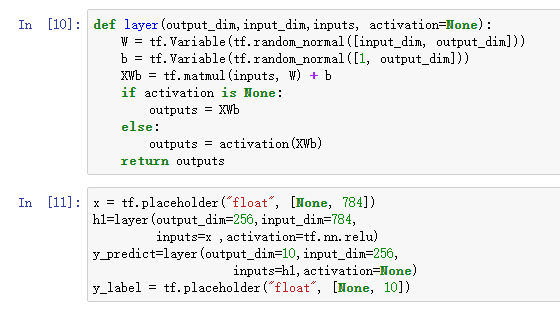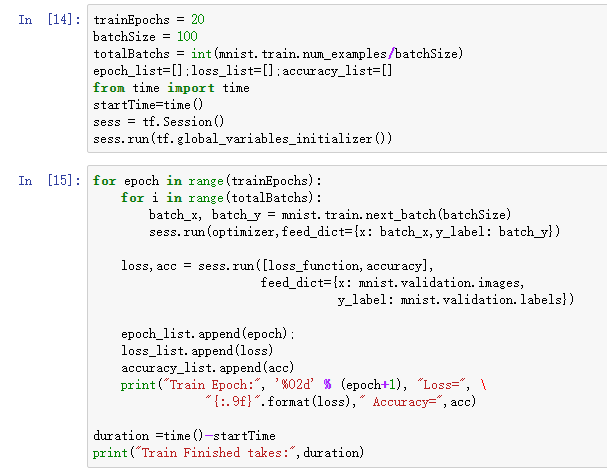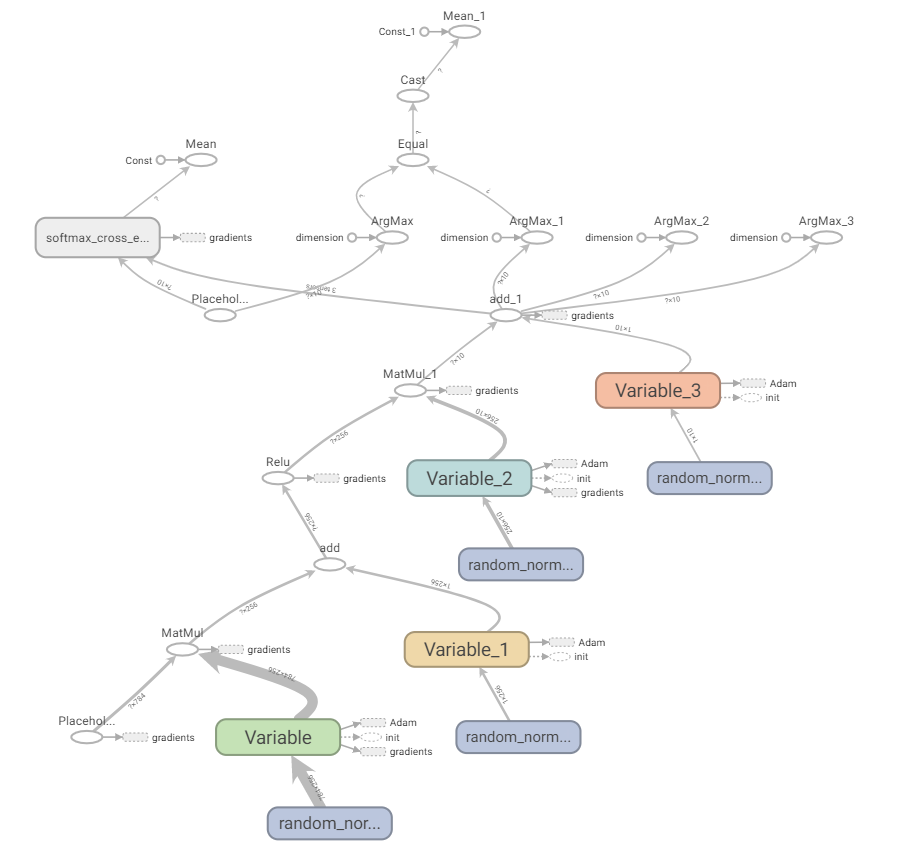
1 # coding: utf-8 2 3 # In[1]: 4 5 import tensorflow as tf 6 import tensorflow.examples.tutorials.mnist.input_data as input_data 7 8 9 # In[2]: 10 11 mnist = input_data.read_data_sets("MNIST_data/", one_hot=True) 12 13 14 # In[3]: 15 16 print('train',mnist.train.num_examples, 17 ',validation',mnist.validation.num_examples, 18 ',test',mnist.test.num_examples) 19 20 21 # In[4]: 22 23 print('train images :', mnist.train.images.shape, 24 'labels:' , mnist.train.labels.shape) 25 26 27 # In[5]: 28 29 import matplotlib.pyplot as plt 30 def plot_image(image): 31 plt.imshow(image.reshape(28,28),cmap='binary') 32 plt.gcf().set_size_inches(2, 4) 33 plt.show() 34 35 36 # In[6]: 37 38 plot_image(mnist.train.images[0]) 39 40 41 # In[7]: 42 43 import numpy as np 44 np.argmax(mnist.train.labels[0]) 45 46 47 # In[8]: 48 49 import matplotlib.pyplot as plt 50 def plot_images_labels_prediction(images,labels, 51 prediction,idx,num=10): 52 fig = plt.gcf() 53 fig.set_size_inches(12, 14) 54 if num>25: num=25 55 for i in range(0, num): 56 ax=plt.subplot(5,5, 1+i) 57 58 ax.imshow(np.reshape(images[idx],(28, 28)), 59 cmap='binary') 60 61 title= "label=" +str(np.argmax(labels[idx])) 62 if len(prediction)>0: 63 title+=",predict="+str(prediction[idx]) 64 65 ax.set_title(title,fontsize=10) 66 ax.set_xticks([]);ax.set_yticks([]) 67 idx+=1 68 plt.show() 69 70 71 # In[9]: 72 73 plot_images_labels_prediction(mnist.train.images, 74 mnist.train.labels,[],0) 75 76 77 # In[10]: 78 79 def layer(output_dim,input_dim,inputs, activation=None): 80 W = tf.Variable(tf.random_normal([input_dim, output_dim])) 81 b = tf.Variable(tf.random_normal([1, output_dim])) 82 XWb = tf.matmul(inputs, W) + b 83 if activation is None: 84 outputs = XWb 85 else: 86 outputs = activation(XWb) 87 return outputs 88 89 90 # In[11]: 91 92 x = tf.placeholder("float", [None, 784]) 93 h1=layer(output_dim=256,input_dim=784, 94 inputs=x ,activation=tf.nn.relu) 95 y_predict=layer(output_dim=10,input_dim=256, 96 inputs=h1,activation=None) 97 y_label = tf.placeholder("float", [None, 10]) 98 99 100 # In[12]: 101 102 loss_function = tf.reduce_mean( 103 tf.nn.softmax_cross_entropy_with_logits 104 (logits=y_predict , 105 labels=y_label)) 106 optimizer = tf.train.AdamOptimizer(learning_rate=0.001).minimize(loss_function) 107 108 109 # In[13]: 110 111 correct_prediction = tf.equal(tf.argmax(y_label , 1), 112 tf.argmax(y_predict, 1)) 113 accuracy = tf.reduce_mean(tf.cast(correct_prediction, "float")) 114 115 116 # In[14]: 117 118 trainEpochs = 20 119 batchSize = 100 120 totalBatchs = int(mnist.train.num_examples/batchSize) 121 epoch_list=[];loss_list=[];accuracy_list=[] 122 from time import time 123 startTime=time() 124 sess = tf.Session() 125 sess.run(tf.global_variables_initializer()) 126 127 128 # In[15]: 129 130 for epoch in range(trainEpochs): 131 for i in range(totalBatchs): 132 batch_x, batch_y = mnist.train.next_batch(batchSize) 133 sess.run(optimizer,feed_dict={x: batch_x,y_label: batch_y}) 134 135 loss,acc = sess.run([loss_function,accuracy], 136 feed_dict={x: mnist.validation.images, 137 y_label: mnist.validation.labels}) 138 139 epoch_list.append(epoch); 140 loss_list.append(loss) 141 accuracy_list.append(acc) 142 print("Train Epoch:", '%02d' % (epoch+1), "Loss=", "{:.9f}".format(loss)," Accuracy=",acc) 143 144 duration =time()-startTime 145 print("Train Finished takes:",duration) 146 147 148 # In[16]: 149 150 get_ipython().magic('matplotlib inline') 151 import matplotlib.pyplot as plt 152 fig = plt.gcf() 153 fig.set_size_inches(4,2) 154 plt.plot(epoch_list, loss_list, label = 'loss') 155 plt.ylabel('loss') 156 plt.xlabel('epoch') 157 plt.legend(['loss'], loc='upper left') 158 159 160 # In[17]: 161 162 plt.plot(epoch_list, accuracy_list,label="accuracy" ) 163 fig = plt.gcf() 164 fig.set_size_inches(4,2) 165 plt.ylim(0.8,1) 166 plt.ylabel('accuracy') 167 plt.xlabel('epoch') 168 plt.legend() 169 plt.show() 170 171 172 # In[18]: 173 174 print("Accuracy:", sess.run(accuracy, 175 feed_dict={x: mnist.test.images, 176 y_label: mnist.test.labels})) 177 178 179 # In[19]: 180 181 prediction_result=sess.run(tf.argmax(y_predict,1), 182 feed_dict={x: mnist.test.images }) 183 prediction_result[:10] 184 185 186 # In[20]: 187 188 plot_images_labels_prediction(mnist.test.images, 189 mnist.test.labels, 190 prediction_result,0) 191 192 193 # In[21]: 194 195 y_predict_Onehot=sess.run(y_predict, 196 feed_dict={x: mnist.test.images }) 197 y_predict_Onehot[8] 198 199 200 # In[22]: 201 202 for i in range(400): 203 if prediction_result[i]!=np.argmax(mnist.test.labels[i]): 204 print("i="+str(i)+ 205 " label=",np.argmax(mnist.test.labels[i]), 206 "predict=",prediction_result[i]) 207 208 209 # In[ ]:
代码如上。
手动建立好输入层,隐层,输出层。

设置损失函数,优化器:

评估方式与准确率:

开始分批次训练:

训练完成后的准确率:

查看某项中的预测概率:

筛选出预测失败的数据:

可以通过:
tf.summary.merge_all()
train_writer = tf.summary.FileWriter('log/area',sess.graph)
保存图。
通过tensorboard --logdir="路径",打开服务,通过输入localhost:6006之类打开网站。
查看生成的图:

